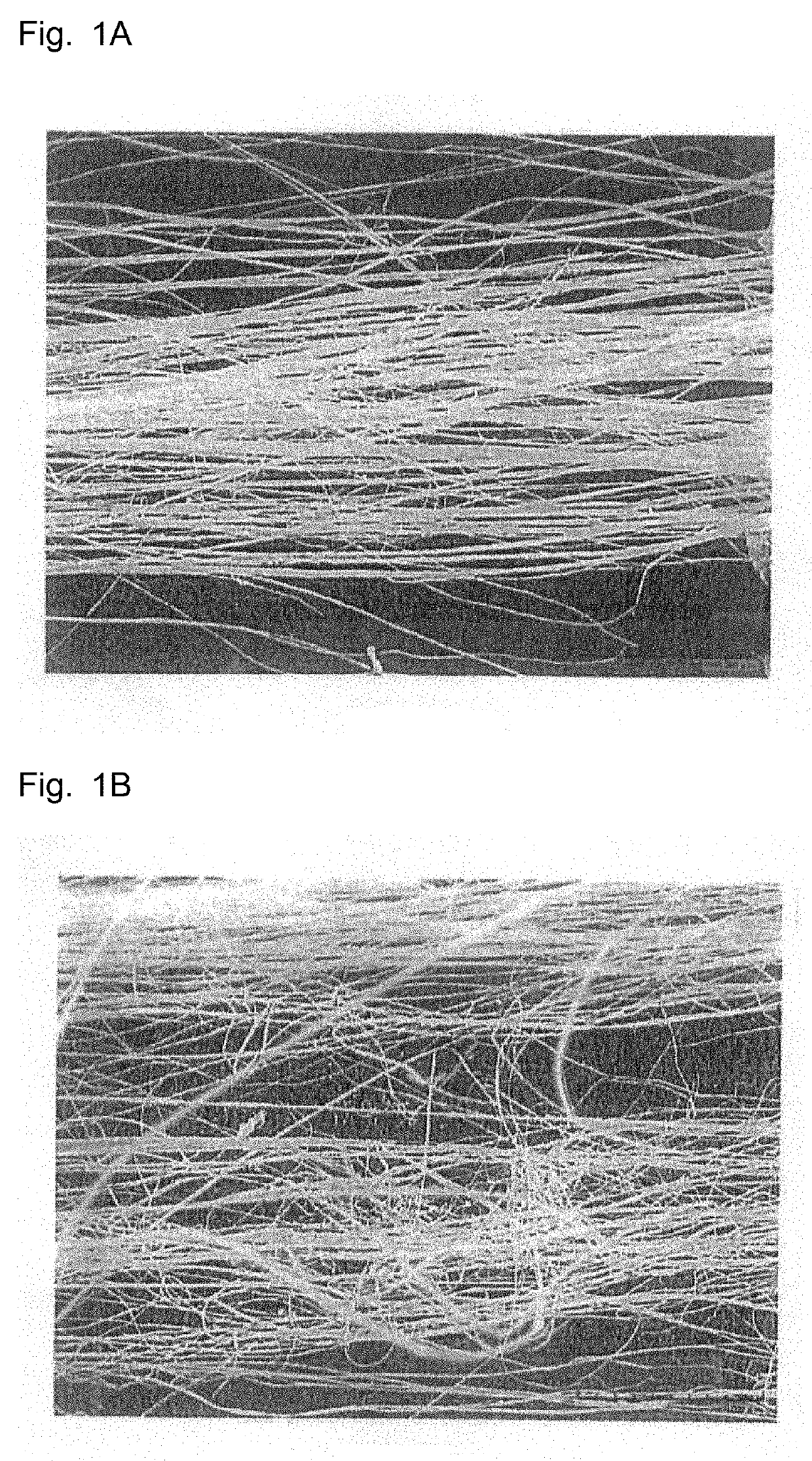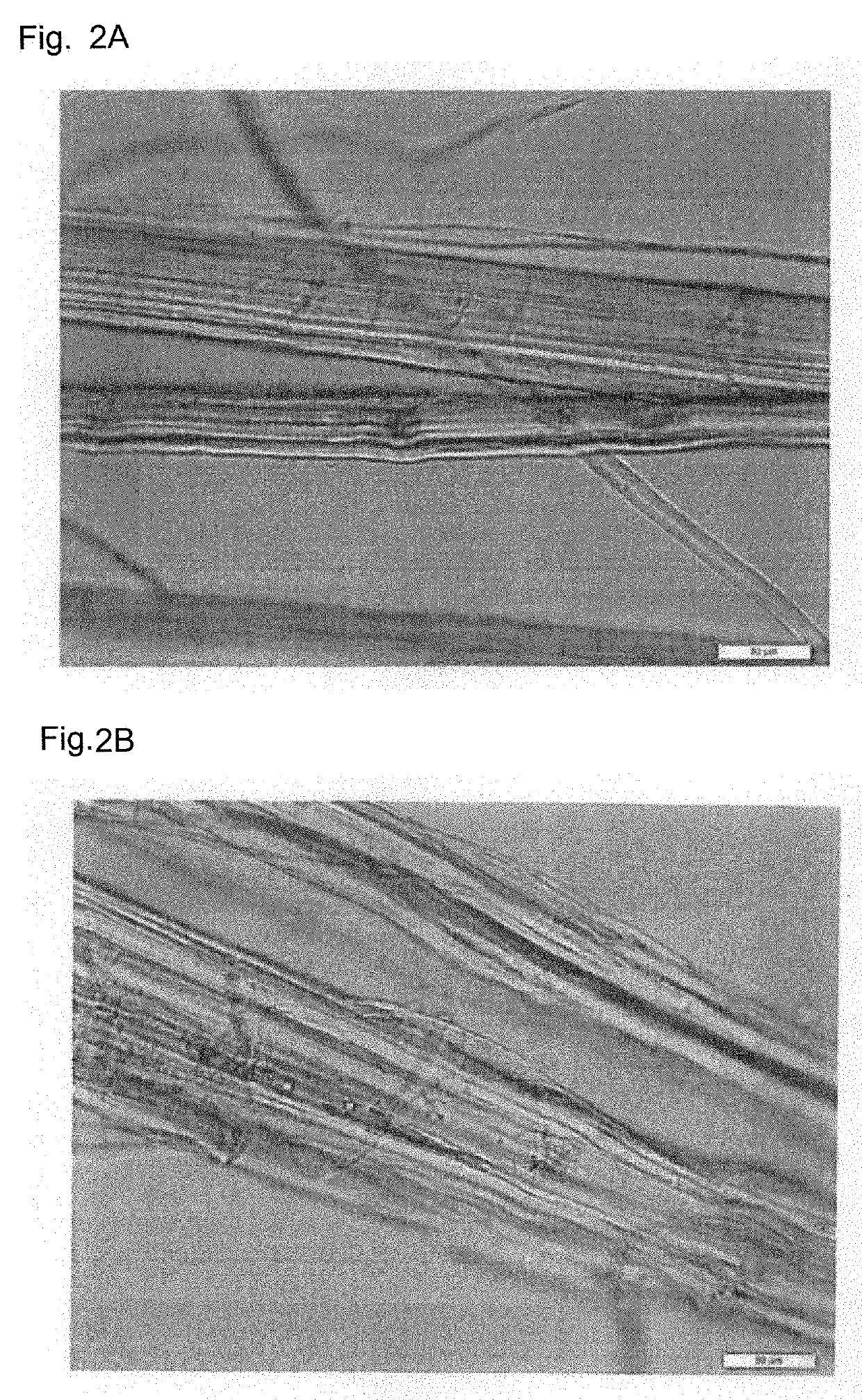Production method of hemp fiber for spinning and hemp fiber for spinning
a production method and technology of hemp fiber, which are applied in the direction of vegetal fibers, yarn, biochemical treatment with enzymes/microorganisms, etc., can solve the problems of not considering the application of working raw fiber materials, difficult material work, and worsening the feel, so as to improve the solubility of lignin and the like, improve the permeability of the enzyme toward the fiber, and improve the effect of lignin solubility
- Summary
- Abstract
- Description
- Claims
- Application Information
AI Technical Summary
Benefits of technology
Problems solved by technology
Method used
Image
Examples
example 1
[0122]Hemp was cut into 10 cm lengths to prepare 100 g of raw hemp fiber for treatment.
[0123]An alkaline pre-treatment liquid having a pH of 11 was prepared using a 25% by mass sodium hydroxide aqueous solution, the 100 g of raw hemp fiber was added to the pre-treatment liquid, and dirt was removed by immersing the raw hemp fiber for 45 minutes at 90° C. The hemp fiber was taken out from the alkaline pre-treatment liquid, well water-washed, and dried.
[0124]2 kg of water was placed in a stainless steel container, 4 g of cellulase (CELLACID VS-2: trade name, manufactured by Servicetec Japan Corporation) and 4 g of a 25% by mass sodium hydroxide aqueous solution were added and well agitated to prepare a treatment liquid. The pH of the treatment liquid was measured using a pH meter (HM-30R: trade name, manufactured by DKK-TOA Corporation). The pH was 11 at 25° C.
[0125]The treatment liquid was heated to 60° C., 100 g of the raw hemp fiber from which dirt had been removed by treatment wit...
example 2
[0136]Hemp was cut into 10 cm lengths to prepare 100 g of raw hemp fiber for treatment.
[0137]2 kg of water was placed into a stainless steel container, 4 g of cellulase (CELLACID VS 2: trade name, manufactured by Servicetec Japan Corporation) and 4 g of 25% by mass sodium hydroxide aqueous solution were added and well agitated to prepare the treatment liquid as in Example 1.
[0138]The treatment liquid was heated to 60° C., the prepared 100 g of raw hemp fiber was immersed in the treatment liquid, the liquid temperature was kept at 60° C., and the raw hemp fiber was held immersed for 30 minutes while agitating.
[0139]After immersion, the hemp was lifted out from the stainless steel container, the treatment liquid placed in the stainless steel container was removed, the container was water-washed, and then 500 g of new water and 2 g of sodium nitrobenzenesulfonate were placed in the stainless steel container and well agitated to prepare a post-treatment liquid.
[0140]The hemp lifted out ...
PUM
| Property | Measurement | Unit |
|---|---|---|
| temperature | aaaaa | aaaaa |
| lengths | aaaaa | aaaaa |
| lengths | aaaaa | aaaaa |
Abstract
Description
Claims
Application Information
 Login to View More
Login to View More - R&D
- Intellectual Property
- Life Sciences
- Materials
- Tech Scout
- Unparalleled Data Quality
- Higher Quality Content
- 60% Fewer Hallucinations
Browse by: Latest US Patents, China's latest patents, Technical Efficacy Thesaurus, Application Domain, Technology Topic, Popular Technical Reports.
© 2025 PatSnap. All rights reserved.Legal|Privacy policy|Modern Slavery Act Transparency Statement|Sitemap|About US| Contact US: help@patsnap.com


